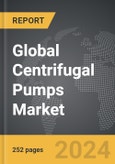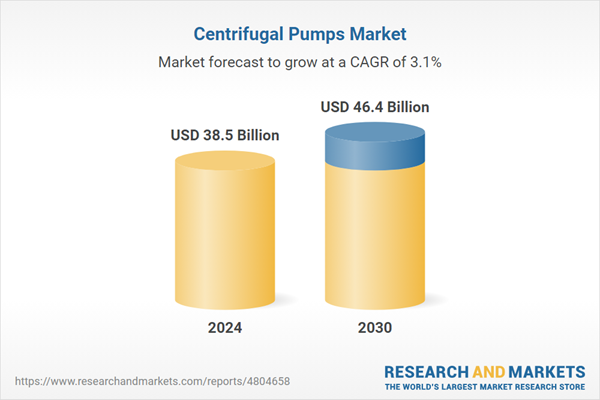The global market for Centrifugal Pumps was valued at US$38.5 Billion in 2024 and is projected to reach US$46.4 Billion by 2030, growing at a CAGR of 3.1% from 2024 to 2030. This comprehensive report provides an in-depth analysis of market trends, drivers, and forecasts, helping you make informed business decisions. The report includes the most recent global tariff developments and how they impact the Centrifugal Pumps market.
Segments: Type (Overhung Impeller, Vertically Suspended, Between Bearing); Stage (Single Stage, Multistage); End-Use (Industrial, Commercial & Residential).
Geographic Regions/Countries: World; United States; Canada; Japan; China; Europe (France; Germany; Italy; United Kingdom; Spain; Russia; and Rest of Europe); Asia-Pacific (Australia; India; South Korea; and Rest of Asia-Pacific); Latin America (Argentina; Brazil; Mexico; and Rest of Latin America); Middle East (Iran; Israel; Saudi Arabia; United Arab Emirates; and Rest of Middle East); and Africa.
The analysts continuously track trade developments worldwide, drawing insights from leading global economists and over 200 industry and policy institutions, including think tanks, trade organizations, and national economic advisory bodies. This intelligence is integrated into forecasting models to provide timely, data-driven analysis of emerging risks and opportunities.
Global Centrifugal Pumps Market - Key Trends and Drivers Summarized
What Are Centrifugal Pumps and How Do They Work?
Centrifugal pumps are among the most commonly used types of pumps in various industries, designed to move fluids through the conversion of rotational kinetic energy to hydrodynamic energy. But how exactly does this process work? At its core, a centrifugal pump relies on a rotating impeller inside the pump’s casing. As fluid enters through the inlet, the impeller spins, creating a centrifugal force that pushes the fluid outward towards the edges of the impeller. From there, the fluid moves through the volute (the pump casing) and exits the pump at a higher pressure and velocity. Centrifugal pumps are widely valued for their simplicity, efficiency, and versatility, making them suitable for a range of liquids, including water, oils, chemicals, and slurries. Their design enables them to handle large volumes of fluid with minimal mechanical complexity, which results in lower maintenance and operational costs compared to other pump types. Despite their relative simplicity, selecting the right centrifugal pump involves careful consideration of the fluid’s properties, including viscosity, temperature, and corrosiveness, to ensure optimal performance.Why Are Centrifugal Pumps Vital Across Multiple Industries?
Why have centrifugal pumps become indispensable in industries as diverse as water treatment, oil and gas, chemical manufacturing, and food processing? The answer lies in their ability to efficiently handle large quantities of fluid at a consistent rate. In municipal water systems, centrifugal pumps are central to both water supply and wastewater treatment, ensuring safe distribution and removal of water in urban areas. In the oil and gas industry, these pumps play a critical role in the transportation of petroleum products through pipelines, as well as in the refining process, where high pressures and temperatures are commonplace. Chemical manufacturers rely on centrifugal pumps to handle aggressive or hazardous substances, requiring specialized pump designs and materials to prevent corrosion and leaks. Even in food and beverage production, centrifugal pumps are used for transferring liquids like milk, juice, and beer while maintaining the integrity and quality of the product. Additionally, the pharmaceutical sector utilizes centrifugal pumps for creating sterile environments essential for drug manufacturing. The flexibility of centrifugal pumps to adapt to different industrial needs through modifications in material, size, and performance characteristics explains their ubiquity across these sectors.What Are the Key Technological Advancements in Centrifugal Pumps?
Technological advancements in centrifugal pumps have been key to enhancing their performance, efficiency, and sustainability in various industrial settings. Innovations in material science have led to the development of pumps made from corrosion-resistant alloys and composites, allowing them to handle more aggressive chemicals and operate under harsher environmental conditions. Another major advancement is the rise of energy-efficient designs, with the integration of variable frequency drives (VFDs) that adjust the pump’s speed based on demand, significantly reducing energy consumption in industries like HVAC, where load conditions fluctuate. The implementation of smart pumps and IoT-enabled monitoring systems is another significant trend. These technologies allow for real-time data collection on pump performance, fluid levels, and operational health, making it easier to detect potential failures before they happen. Predictive maintenance, enabled by AI and machine learning algorithms, has helped reduce downtime and extend the lifespan of the equipment. Additionally, improvements in impeller design, such as the use of multi-stage impellers, have enabled pumps to achieve higher pressures with better efficiency, opening up new applications in industries that require precise fluid control. These advancements not only improve the functionality of centrifugal pumps but also ensure they meet modern environmental and operational standards.What Factors Are Driving Growth in the Centrifugal Pump Market?
The growth in the centrifugal pump market is driven by several factors, reflecting both technological advancements and shifting industry demands. One of the most significant drivers is the increasing global demand for infrastructure development, particularly in water and wastewater management, where centrifugal pumps are essential for urban water distribution and sewage systems. As cities expand and modernize, the need for efficient and reliable water management solutions intensifies, spurring investments in advanced pumping systems. The rise in industrialization, particularly in emerging economies, also fuels demand for centrifugal pumps across sectors like oil and gas, chemicals, and food processing. In these industries, the need for pumps that can handle higher pressures, temperatures, and corrosive substances drives technological innovation and market expansion. Additionally, the growing emphasis on energy efficiency and sustainability has led to widespread adoption of pumps with lower power consumption, such as those equipped with VFDs and smart controls, which are increasingly being mandated by government regulations. Consumer behavior is also shifting, with industries seeking more reliable, maintenance-friendly systems that offer lower total cost of ownership. This demand is amplified by the increasing adoption of automation and IoT in industrial operations, where real-time monitoring of pump performance is crucial for optimizing processes and minimizing downtime. Lastly, heightened awareness of environmental concerns has led to increased usage of centrifugal pumps in renewable energy sectors, such as geothermal and solar thermal power, further expanding their application range.Report Scope
The report analyzes the Centrifugal Pumps market, presented in terms of units. The analysis covers the key segments and geographic regions outlined below.Segments: Type (Overhung Impeller, Vertically Suspended, Between Bearing); Stage (Single Stage, Multistage); End-Use (Industrial, Commercial & Residential).
Geographic Regions/Countries: World; United States; Canada; Japan; China; Europe (France; Germany; Italy; United Kingdom; Spain; Russia; and Rest of Europe); Asia-Pacific (Australia; India; South Korea; and Rest of Asia-Pacific); Latin America (Argentina; Brazil; Mexico; and Rest of Latin America); Middle East (Iran; Israel; Saudi Arabia; United Arab Emirates; and Rest of Middle East); and Africa.
Key Insights:
- Market Growth: Understand the significant growth trajectory of the Overhung Impeller Pumps segment, which is expected to reach US$22.1 Billion by 2030 with a CAGR of a 4.1%. The Vertically Suspended Pumps segment is also set to grow at 2.7% CAGR over the analysis period.
- Regional Analysis: Gain insights into the U.S. market, valued at $10.3 Billion in 2024, and China, forecasted to grow at an impressive 5.7% CAGR to reach $9.6 Billion by 2030. Discover growth trends in other key regions, including Japan, Canada, Germany, and the Asia-Pacific.
Why You Should Buy This Report:
- Detailed Market Analysis: Access a thorough analysis of the Global Centrifugal Pumps Market, covering all major geographic regions and market segments.
- Competitive Insights: Get an overview of the competitive landscape, including the market presence of major players across different geographies.
- Future Trends and Drivers: Understand the key trends and drivers shaping the future of the Global Centrifugal Pumps Market.
- Actionable Insights: Benefit from actionable insights that can help you identify new revenue opportunities and make strategic business decisions.
Key Questions Answered:
- How is the Global Centrifugal Pumps Market expected to evolve by 2030?
- What are the main drivers and restraints affecting the market?
- Which market segments will grow the most over the forecast period?
- How will market shares for different regions and segments change by 2030?
- Who are the leading players in the market, and what are their prospects?
Report Features:
- Comprehensive Market Data: Independent analysis of annual sales and market forecasts in US$ Million from 2024 to 2030.
- In-Depth Regional Analysis: Detailed insights into key markets, including the U.S., China, Japan, Canada, Europe, Asia-Pacific, Latin America, Middle East, and Africa.
- Company Profiles: Coverage of players such as Baker Hughes, a GE company, Circor International, Inc., EBARA Corporation, Flowserve Corporation, Grundfos and more.
- Complimentary Updates: Receive free report updates for one year to keep you informed of the latest market developments.
Some of the 58 companies featured in this Centrifugal Pumps market report include:
- Baker Hughes, a GE company
- Circor International, Inc.
- EBARA Corporation
- Flowserve Corporation
- Grundfos
- ITT Corporation
- KSB AG
- Pentair Plc
- Someflu SAS
- Sulzer Ltd.
- The Weir Group PLC
- WILO SE
- Xylem, Inc.
Tariff Impact Analysis: Key Insights for 2025
Global tariff negotiations across 180+ countries are reshaping supply chains, costs, and competitiveness. This report reflects the latest developments as of April 2025 and incorporates forward-looking insights into the market outlook.The analysts continuously track trade developments worldwide, drawing insights from leading global economists and over 200 industry and policy institutions, including think tanks, trade organizations, and national economic advisory bodies. This intelligence is integrated into forecasting models to provide timely, data-driven analysis of emerging risks and opportunities.
What’s Included in This Edition:
- Tariff-adjusted market forecasts by region and segment
- Analysis of cost and supply chain implications by sourcing and trade exposure
- Strategic insights into geographic shifts
Buyers receive a free July 2025 update with:
- Finalized tariff impacts and new trade agreement effects
- Updated projections reflecting global sourcing and cost shifts
- Expanded country-specific coverage across the industry
Table of Contents
I. METHODOLOGYII. EXECUTIVE SUMMARY2. FOCUS ON SELECT PLAYERSIII. MARKET ANALYSISCANADAITALYSPAINRUSSIAREST OF EUROPESOUTH KOREAREST OF ASIA-PACIFICARGENTINABRAZILMEXICOREST OF LATIN AMERICAIRANISRAELSAUDI ARABIAUNITED ARAB EMIRATESREST OF MIDDLE EASTIV. COMPETITION
1. MARKET OVERVIEW
3. MARKET TRENDS & DRIVERS
4. GLOBAL MARKET PERSPECTIVE
UNITED STATES
JAPAN
CHINA
EUROPE
FRANCE
GERMANY
UNITED KINGDOM
ASIA-PACIFIC
AUSTRALIA
INDIA
LATIN AMERICA
MIDDLE EAST
AFRICA
Companies Mentioned (Partial List)
A selection of companies mentioned in this report includes, but is not limited to:
- Baker Hughes, a GE company
- Circor International, Inc.
- EBARA Corporation
- Flowserve Corporation
- Grundfos
- ITT Corporation
- KSB AG
- Pentair Plc
- Someflu SAS
- Sulzer Ltd.
- The Weir Group PLC
- WILO SE
- Xylem, Inc.
Table Information
| Report Attribute | Details |
|---|---|
| No. of Pages | 252 |
| Published | April 2025 |
| Forecast Period | 2024 - 2030 |
| Estimated Market Value ( USD | $ 38.5 Billion |
| Forecasted Market Value ( USD | $ 46.4 Billion |
| Compound Annual Growth Rate | 3.1% |
| Regions Covered | Global |









